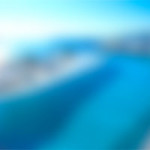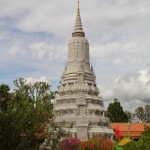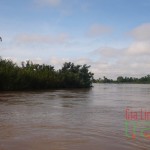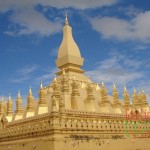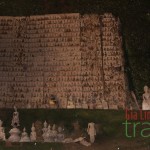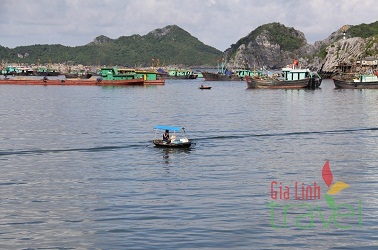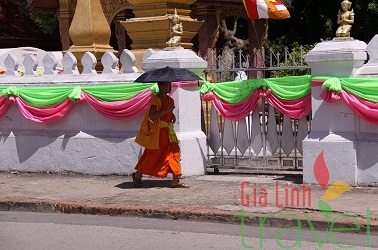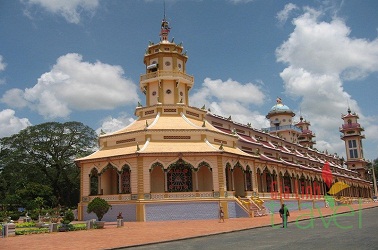Destination: Siem Reap/Phnom Penh/Kratie/Stung Treng/Dongkralo/Khong Island/Wat Phou/Pakse/Vientiane/Luang Prabang/Pak Ou Cave
B=Breakfast, L=Lunch, D=Dinner, G=Guide
Day 1: Siem Reap arrival (G)
Arrival in Siem Reap, met and transferred to the hotel for check in. Then, you’ll be free. Overnight in Siem Reap.
Day 2: Siem Reap (B, L, G)
After breakfast, you’ll visit the Roluos Group. The monuments of Roluos, which served as the capital of Indravarman I (reigned 877-89), are among the earliest large, permanent temples built by the Khmers and mark the beginning of Khmer classical art. Preah Ko erected by Indravarman I in the late 9th century dedicated by the King to his ancestors in 880. Bakong the largest and most interesting of the Roluos group temples, with his active Buddhist monastery just to the north of the east entrance. Lolei built on an islet in the center of a large reservoir (now rice fields) by Yasovarman I, the founder to the first city at Angkor. Overnight in Siem Reap.
Day 3: Siem Reap (B, L, G)
Morning, transfer to Banteay Srei temple (10th century), regarded as the jewel in the crown of Classical Khmer Art. Continue to Ta Prohm, one of the area’s most beautiful temples. Ta Prohm has been relatively untouched since it was discovered and retains much of its mystery. Lunch at local restaurant. In the afternoon, you continue your temple visits to Preah Khan. Built by the King Jayavarman VII, Preah Khan is, like Ta Prohm, a place of towered enclosures and shoulder hugging corridors. Unlike Ta Prohm, however, the temple of Prea Khan is in a reasonable state of preservation and ongoing restoration efforts should maintain and even improve this situation. Neak Pean, a fountain built in the middle of a pool (representing the paradisiacal Himalayan mountain-lake), Ta Som and Banteay Samre, built in the third quarter of the 12th century. It consists of a central temple with four wings preceded by a hall and accompanied by two libraries, the southern example remarkably well preserved. Two concentric walls enclose the ensemble. Overnight in Siem Reap
Day 4: Siem Reap/Phnom Penh (B, L, G)
Breakfast at the hotel and transfer to pier to for local speedboat trip at 07:00 am to Phnom Penh. Arrival around noon time. At the end of dry season speed boat operation is limited due to the low water level. In this case the journey to Phnom Penh is flight. Afternoon Visit the Royal Palace, built by King Norodom in 1866 on the site of the old town, and the Silver Pagoda. Located within the grounds of the Royal Palace, the Silver Pagoda is so named because of its floor, which is made up of 5000 silver tiles. The treasures found inside include a solid gold Buddha encrusted and weighing 90kilograms and a small 17th century emerald and baccarat crystal Buddha. End your afternoon with the visit of the Wat Phnom Temple, Phnom Penh’s namesake, from where you can enjoy views over the tree-lined avenues. The guide in the Laotian side who will pick up you and transfer to Khong Island. Khong Island is part of Siphandone, Laotian for ’4000 islands’. During the dry season thousands of shoals and small islands appear due to the descending water level, giving the impression of a vast area of islets. Overnight in Khong Island
Day 5: Phnom Penh/Kratie (B, L, G)
Breakfast at hotel and drive to Kratie via Kompong Cham. Lunch at local restaurant. Arrival in Kratie and check in at hotel. In the afternoon, city tour of this small provincial town with its good examples of sumptuous colonial architecture. This tiny town on the Mekong is an unexpected delight, with a relaxing, indolent atmosphere. Further north stop at the best riverside vantage point from which to view the rare freshwater Irrawady dolphins which can be best seen late afternoon. Then, drive back to Kratie. Overnight in Kratie.
Day 6: Kratie/Stung Treng (B, L, G)
Breakfast in hotel then transfer by vehicle from Kratie to Stung Treng, a very laid back town located on the banks of the Mekong. Journey along the Mekong River basin through the villages of Sambok, Sre Sbov and Phumi Prek Preah. The Mekong River, which rises in Tibet, flows 315 km through Cambodia before continuing on through Vietnam to the sea. Overnight in Stung Treng.
Day 7: Stung Treng/Dongkralor/Khong Island (B, L, G)
Today you will cross into Laos by a local speed boat to the Cambodian-Lao border. A stunning boat trip of about an hour and a half over a deserted part of the Mekong river will bring you to Dongkralor the border. You must have Lao visa beforehand ! On completion of immigration formalitiesalk to the upper part of the temple is steep, but the view over the surrounding countryside is rewarding indeed. Arrival in Pakse, check in hotel. Overnight in Pakse
Day 8: Khong Island (B, L, G)
Morning, cruise along the backwaters to explore Siphandone. Visit the surrounding islands of Done Ket and Done Som for a glimpse into the traditional lifestyle of the fishermen. Continue to Done Khone Island. Lunch at local restaurant in Ban Khone. Then visit Done Khone Island and hike along its ancient railway built by the French in 1897 in order to bypass the powerful rapids when transporting goods from Cambodia. Continue to Sumphamith Waterfall. In the dry season, the Irrawaddy Dolphins, one of the world’s rarest large mammal species, congregate at the base of the rapids to hunt the fish that survive in the deep pools. Spend a relaxing hour watching these extremely shy and endangered freshwater dolphins. Return by boat to Khong Island. Overnight in Khong Island.
Day 9: Khong Island/Wat Phou/Pakse (B, L, G)
This morning, departure for Pakse. Along the way you will visit Wat Phou. This Khmer temple was built in the 5th century thus predating Angkor Wat in Cambodia. In 2002 Wat Phou was declared a World Heritage Site by UNESCO. The w of the city during sunset. Overnight in Phnom Penh.
Day 10: Pakse/Vientiane (B, L, G)
Morning transfer to airport for flight to Vientiane. In the afternoon, we take a sightseeing tour of Vientiane, to visit religious museums of Wat Sisaket, the oldest temple to have been survived from the Siamese war of 1828 and its cloister contains more than 8000 Buddha statues; Wat Ho Prakeo, the former home-temple of the Emerald Buddha statue or Pra Keo, but today it contains a collection of Buddha statues, antiques and all artifacts found in around Vientiane; That Luang Stupa, the single most important monument in Laos, which was built to cover the original small stupa containing a piece of the chest bone of Buddha; Patouxay (Arch de Triumph), built quite recently in commemoration of those who died during the wars in the past and it is today as the land-mark of Vientiane. Overnight in Vientiane
Day 11: Vientiane/Luang Prabang (B, L, G)
After breakfast, we transfer to the airport for the flight to Luang Prabang, transfer to hotel. Today’s city tour of the former Royal capital, Luang Prabang, include a visit to Wat Visoun, the site of the impressive Thad Makmo stupa and Phou Si hill which stands right in the centre of the small city, where you can climb its 350 steps to enjoy commanding views over the Mekong. Wat Phu Si sits atop the mountain, alongside the skeletons of Indochina war anti-aircraft guns. Then we continue, visiting Wat Mai (1796) with its five-tiered roof, and Wat Xieng Thong which is considered to characterize the uniqueness of Luang Prabang’s local style, its several roofs sweeping low to the ground. We see also the impressive “tree of life” mosaic here. After that we visit the National Museum, which was once the king’s palace. Displayed inside is a collection of personal artifacts of the former royal family. Overnight in Luang Prabang.
Day 12: Luang Prabang/Pak Ou Cave (B, L, G)
After breakfast, we board a cruise heading upstream on the Mekong River, giving a panoramic view of the tranquil countryside. Our first stop is the village of Ban Muangkeo where we start a short trek (45 mins) to reach the mysterious Pak Ou Caves, two linked caves crammed with thousands of gold lacquered Buddha statues of various shapes and sizes left by pilgrims. En route, we stop at the village of Ban Xanghai, where the local specialty of rice wine is produced. On the way, we also visit Ban Xangkhong, Ban Xienglek and Ban Nong Xai, small villages well known for silk weavings and for Saa (jute) Papermaking. Return and overnight in Luang Prabang.
Day 13: Luang Prabang departure (B, G)
After breakfast, you’ll be free to do what you wish and then transfer to the airport for your departure flight.
